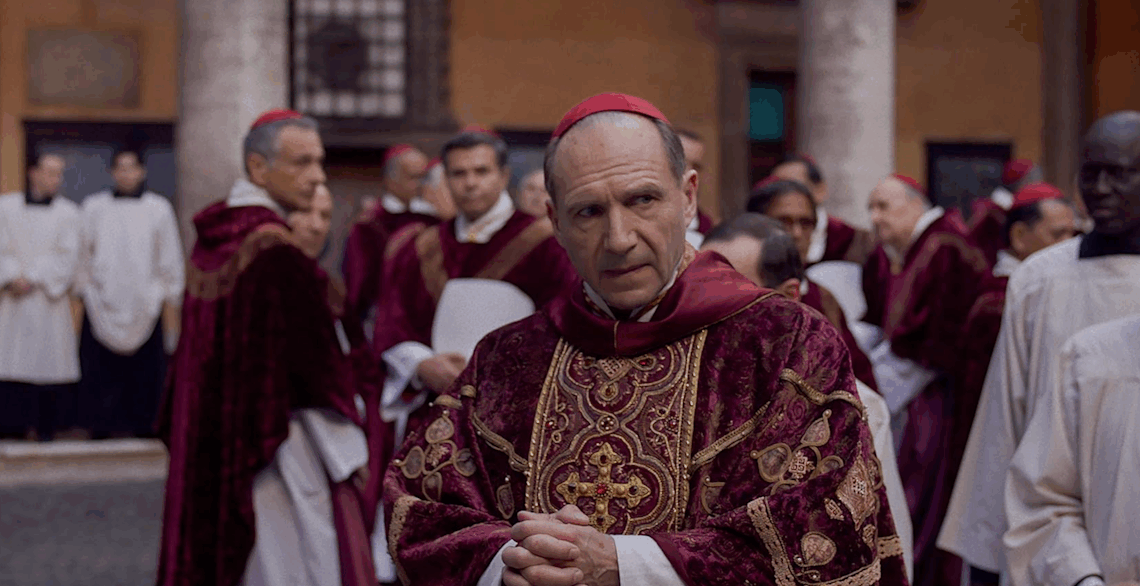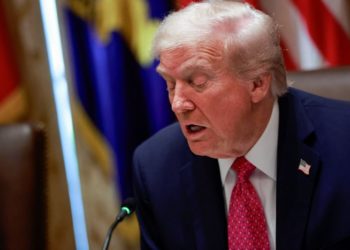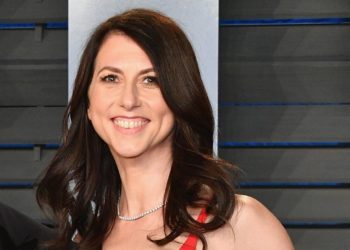In the film “Conclave,” now streaming on Prime Video, Ralph Fiennes plays a Catholic cardinal presiding over the election of a new pope. In real life, that task falls to Cardinal Pietro Parolin, a close ally of the late Pope Francis and a presumed front-runner among papal candidates.
How accurately does the Oscar-nominated “Conclave” match an actual conclave — the process of electing a pope that will begin Wednesday? For the most part, very much so. With some significant caveats.
Warning: There are a few “Conclave” spoilers ahead. Sadly, we do not have any spoilers about the real-life conclave.
From all accounts, “Conclave” accurately reflected the arcane mechanics of how a pope is selected: In the Sistine Chapel, cardinals write their vote on paper ballots, depositing them into an urn. The names are read aloud and, once tallied, are threaded with a needle onto a string.
After each round of voting, the string is tied, the garland of ballots is burned and a chemical is added to the fire to produce either black smoke, which signals to the public that the conclave will continue, or white smoke, which indicates that a two-thirds majority have elected a new pope.
“Conclave” got all this right.
Just as in the movie, before the conclave begins, the windows are shuttered, phones are confiscated and electronic jammers are deployed to prevent access to the internet. It protects the conclave from undue outside influence and keeps the selection process secret.
But after the pope has been selected?
“That’s where you get the leaking,” said Daniel A. Rober, chair of the Catholic Studies department at Sacred Heart University in Fairfield, Connecticut. “After the act, you find out who all the candidates were, even though no one is ever supposed to speak of this.”
That’s how the public learned that Cardinal Jorge Mario Bergoglio — who would adopt the name Pope Francis in 2013 — was a final candidate during the 2005 conclave. That’s also how we heard that Bergoglio withdrew himself from consideration, paving the way for Cardinal Joseph Ratzinger to become Pope Benedict XVI.
Rober said that “Conclave” accurately reflected the ideological debates that happen when the Roman Catholic Church is selecting a new pope. “There are political factions, there are different groups of cardinals with different kinds of agendas for the future of church,” Rober said.
But the movie fudged the timing of these debates. According to Rober, “the time for the drama that takes place in the movie ‘Conclave’” is during the “general congregations” when cardinals convene before the conclave officially begins.
Over the years, the Vatican has included more pre-conclave open discussions to make the conclaves faster and more efficient. A long conclave can signal contention and undermine the authority of the church.
“It would sow division among the faithful,” Rober said.
But this can make the weeks leading up the conclave spicier.
The general congregations are frequently when factions and rivalries begin to play out in the media — especially in Italy, where the press and public have been especially captivated by Vatican palace intrigue for centuries. Ahead of this conclave, gossip has been swirling about two front-runners, Parolin, a solemn man from Italy known for his steady stay-the-course leadership and unreadable face, and Cardinal Luis Antonio Tagle from the Philippines, described by Rober as “the closest to a natural successor to Francis in style and substance as one will find in this conclave.”
Joanne M. Pierce, a professor emerita in the Religious Studies Department at College of the Holy Cross in Worcester, Massachusetts, thinks “Conclave” may have exaggerated the electioneering.
“Active ‘campaigning’ for the position is strictly forbidden, and I think some of the side conversations among the cardinals in the film come a little too close to campaigning,” wrote Pierce in an email.
There is an oft-repeated aphorism about front-runners at a conclave: He who “walks in a pope, walks out a cardinal.” Too much ambition can be enough to kill a cardinal’s chance at the papacy.
Stanley Tucci’s character arc as Cardinal Bellini pointed to this paradox. In “Conclave,” Bellini initially adopted the pose of a reluctant candidate. It wasn’t until he was out of the running that he admitted to Ralph Fiennes’s character that he had already picked out his papal name.
But some Catholic experts stress that a conclave is at its heart a spiritual event.
“We oftentimes think about a papal conclave as if we are on Capitol Hill. That’s not the case,” said Kurt Martens, a professor with the School of Canon Law at Catholic University of America, at a lecture in April. “It is also a prayerful event. Let’s not forget that.”
Robert Harris, who wrote the novel “Conclave,” on which the movie was based, said he tried to make his story “as accurate as I possibly could” and that there were “astonishingly few differences” between his novel and the film.
“In all, I’ve had nine adaptations to screen of [my] books and I would say that this was the most faithful, even including two that I adapted myself,” Harris said.
As part of his research, Harris read all four gospels of the New Testament and studied the rules that govern the Vatican City State. Harris was also granted access to parts of the Vatican that are depicted in “Conclave.” From what he remembers, the movie captured the look and feel of the rooms in which the cardinals board during the Conclave.
“It’s not horrible, but it’s not very nice,” Harris said of the cardinals’ accommodations. One man Harris spoke with compared his room to one that would be in a private clinic or rehab facility.
“Conclave” featured a kitchen staffed entirely by nuns in habits. It’s a stark visual, and perhaps a metaphor for the relegated role of women in the church. But it’s not entirely accurate.
The Vatican staff also includes laity and non-Catholics. Older cardinals are sometimes accompanied at the conclave by nurses or other staff, who were also absent from the movie.
And while Isabella Rossellini’s impromptu speech (and curtsy) was one of the most memorable moments in the movie, it wasn’t realistic. “It is unlikely that one of the religious sisters serving as cooks and housekeepers during the conclave will address the cardinals in the dining room,” Pierce wrote.
“Conclave” features a plot involving Cardinal Tremblay (played by John Lithgow) being accused of covert simony, or ecclesiastical bribery.
Historically, there have been several rumored incidents of papal simony. Pope Alexander VI, elected in 1492, was rumored to have bought his papacy with four mule-loads of silver, though that story has never been substantiated. Pope Benedict IX, elected in 1032, and Pope Symmachus, elected in 498, were also dogged by bribery rumors.
“I can promise you that over the 2,000-year history of the church, there has been plenty of grubby dealmaking at conclaves,” said Philip Shenon, a former New York Times investigative reporter and author of “Jesus Wept: Seven Popes and the Battle for the Soul of the Catholic Church.”
Money still plays a role in contemporary papal politics. “There’s a lot of influence of very conservative, wealthy American Catholics on what goes on outside the conclave,” Shenon said.
One group of Catholics called the Better Church Governance Group has been raising funds for several years to compile its “Red Hat Report,” which assembled dossiers on potential candidates for pope and has been harshly critical of Parolin.
Rober sees similarities in how “dark money” and powerful special interest groups can influence American politics and the ways that well-funded Catholic organizations will conduct research on papal candidates “to find dirt on them, to find things that might tarnish their images.”
But Shenon isn’t convinced that efforts from well-heeled American Catholic conservatives will necessarily be fruitful.
“Eighty percent of the cardinals who will vote were men who were put there by Francis, and Francis wasn’t in the business of finding cardinals who were arch-conservatives, who would oppose his legacy,” Shenon said. “It seems much more likely that the conclave is going to choose a new pope who will be very much in line with the legacy of Francis.”
“Conclave” hinges on the character Cardinal Benitez (played by Carlos Diehz), a dark-horse candidate from a church in Afghanistan. In the film, Benitez is a surprise guest who is allowed into the proceedings after they determine that he was appointed cardinal in pectore, a term used for bishops who are privately appointed as cardinals by the pope, bypassing the usual public process.
It’s a great plot point. But it’s not really possible.
Politically, it’s extremely unlikely.
“The idea that an unknown candidate would suddenly rise to the top in that way is a little implausible,” Rober said.
Pierce also wrote that there was “very little chance that some surprise scandal will break during the conclave, unlike in the film.”
And while the pope has the authority to appoint in pectore cardinals, Benitez would not have been admitted to the conclave in real life.
“The way that in pectore cardinals work is, if it is not announced by the pope before his death, that status is revoked,” Rober said. “So you can’t just show up at the conclave with a letter saying that you are a cardinal and be admitted.”
The post What ‘Conclave’ gets right — and wrong — about papal politics appeared first on Washington Post.




